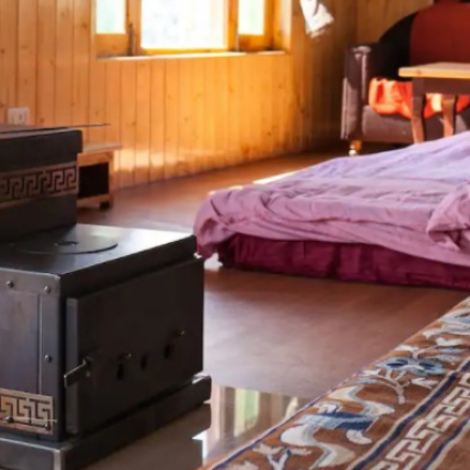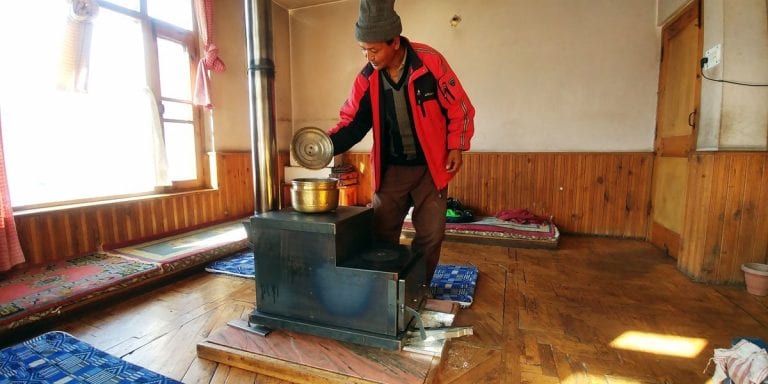The first thing to know about the Himalayan Rocket Stove is that it can cook a meal, but it was built to heat a home. The stove burns wood more efficiently than traditional combustion area heaters in Northern India where it is distributed. Its dual combustion chambers burn wood, and then burn most of the emissions created during the burn. By design it reduces the demand for wood, taking pressure off the region’s disappearing forests, and saves women the trouble of hauling as much wood to heat their homes and cook their meals.
Russel Collins and Nitisha Agarwal created the stove, and their design and business prowess helped them to win the India segment of the American Society of Mechanical Engineers (ASME) Innovation Showcase (ISHOW) in 2019. ISHOW is an international accelerator of innovators that have made physical products, as opposed to software or words, that meet basic needs among underserved communities. Each year, ISHOW awards teams in at events in India, Kenya and the United States. (And ASME is the umbrella organization over Engineering for Change).
In a collaboration with the Lemelson Foundation, one of the sponsors of ISHOW, we’re taking a new look at ISHOW winners to learn about their innovations and their progress to date. We asked Russel Collins and Nitisha Agarwal five questions.
E4C: What kind of tech are your stoves replacing?
RC: The traditional tech for space heating is burning wood or dung in a simple metal box with a flue pipe to exit smoke. These are inefficient to use, generate lots of smoke in the ambient air outside the home, and radiate a sharp and less comfortable heat. They are also traditionally used for cooking on when in use as a heater, so we have adapted to this usage pattern with our product design (this was a major point of design which is key to the acceptance of our stoves by Himalayan users).
E4C: How has your business progressed since ISHOW? Would you mind sharing sales or other figures?
RC: Approximately doubling unit sales and revenue year on year since we started. I’ll let Nitisha pop some numbers in here.
NA: HRS has sold over 4000 (FY 20-21) units since its inception and we are looking to add close another 4000-4500 units in the ongoing FY.
E4C: What separates Himalayan Rocket Stoves from the competition?
RC: As mentioned above, being focused on space heating is actually our USP. There is no one else in the improved heating space who makes a product that is as familiar and accessible to the users as ours, as far as I know. The core design premise is that the stove should look and feel similar to what people are already used to using with regards to size, shape and functionality. The tech is all interior to the device, and apart from a slightly different lighting procedure, the usage is basically the same as a traditional device. The difference internally is a dual combustion chamber that mixes preheated air into a naturally aspirated vortex at sufficiently high temperatures to oxidize hydrocarbons in the smoke, thus releasing more heat and less smoke to the atmosphere. Thermal efficiency is roughly double, pollution is a small fraction and the quality of heat is much better (more consistent and less ’sharp’) due to heat trapping and higher thermal mass of the unit.
E4C: What is the environmental impact of using the stoves compared to traditional technologies?
RC: Reduction in fuel usage leads to less impact on forest resources, which are being heavily impacted by illegal black market logging to supply fuel wood to Himalayan communities. We are also working now to introduce waste biomass pellets into the fuel supply chain so as to further reduce impacts on forestry. The dramatic drop in black carbon is also significant, as this is a snow and glacial melt accelerant of major impact in Himalayan regions. The NGT (National Green Tribunal) in India has been threatening to ban combustion heaters due to the smoke and black carbon from traditional heaters, but there are no viable alternatives to biomass combustion for heating at this time. Our units effectively solve this issue as they burn with no visible smoke at all after 10-15 minutes of operation. The reduction in smoke pollution also has health benefits to communities as this smoke tends to hang low in the valleys in the winter and has a well documented health impacts.
E4C: Do you have data that support the claims?
NA: Rocket Stove design is based on a dual combustion process using high-temperature clean combustion technology. The Himalayan Rocket Stove uses less than 50 percent of the wood in comparison with a traditional Chulha / Bukhari. (Based on several feedback mechanisms done by our own teams and some third parties who have been keenly collaborating with us.)
These stoves address three key issues, namely, deforestation, women’s health and air pollution. The product further reduces 3 tons of carbon emissions yearly, directly impacting the fragile forest ecosystem. This is based on preliminary calculations by South Pole and is subject to confirmation by Gold Standard. Each HRS in use will save at least one mature tree from being felled each year equivalent, which is 2000 kg of wood.
Saves backs. Each stove saving 2000 kgs of wood means 100 loads of 20 kg each that don’t have to be carried on someone’s back.
Saves time. With a load of wood taking more than three hours to source, saving 100 loads is saving more than 200 hours of labor each year.
Saves money. If not being sourced personally, then the wood is being purchased, often illegally from black market sellers who are secretly felling trees for sale.
Watch the stove at work in slow motion
Russel Collins discusses the Himalayan Rocket Stove at ISHOW India in 2019

